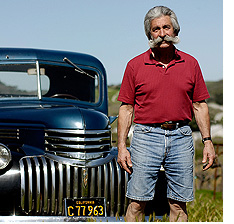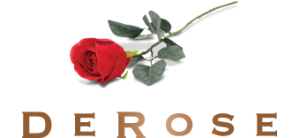The DeRoses behind DeRose Vineyards
Franciscan padres founded California winemaking in the late 1700s using indigenous grapes to vinify sacramental wines. European settlers later pioneered wines made from the grapes of their homelands (Vitis vinifera) in the 1850s. Winemaking was a family affair back then, with the craft typically passed from one generation to the next. Vintner families such as Harazthy, Palmtag, Simi, Parducci and Gundlach were among the most notable.
The 1890s saw the addition of more Italian immigrants to the wine industry. Some producers survived Prohibition, the Great Depression and two World Wars. A few (Sebastiani, Martini, Trinchero and Pedroncelli) remain family owned today and are managed by third or fourth generation winegrowers.
Following the lead of these early California vintners, Winemakers Pat and Al DeRose produce big, bold and rustic wines from handpicked grapes with native yeasts and little-to-no filtration.
Winemaker/Vineyard Manager Pat DeRose
 Like the Italian immigrants who helped trailblaze California winegrowing in the late 1800s, Pat DeRose spends as much time in the vineyard as he does in the winery. This approach to winemaking presents an interesting mix of traditional farming methods and contemporary cellar practices. Pat was born in San Jose in June of 1947. He attended elementary, high school and college in San Jose where he ran track and cross-country in his teens. Family life played a major role in his formative years. Uncle Al DeRose influenced the adolescent Pat in many ways – his love of farming, old cars and of course, big red wines.
Like the Italian immigrants who helped trailblaze California winegrowing in the late 1800s, Pat DeRose spends as much time in the vineyard as he does in the winery. This approach to winemaking presents an interesting mix of traditional farming methods and contemporary cellar practices. Pat was born in San Jose in June of 1947. He attended elementary, high school and college in San Jose where he ran track and cross-country in his teens. Family life played a major role in his formative years. Uncle Al DeRose influenced the adolescent Pat in many ways – his love of farming, old cars and of course, big red wines.
In 1928, Francisco DeRose, Pat’s paternal grandfather, moved the family from South San Francisco to a 60-acre ranch in the Willow Glen area of San Jose. Led by Pat’s father Gene DeRose, the family grew prunes, cherries and apricots. The ranch provided a comfortable lifestyle for three generations of the family. They eventually sold the land in 1970 after 40 years of commercial farming.
In 1974 Uncle Al dug a cellar beneath his San Jose home and began making small lots of zinfandel, gewurztraminer and a Bordeaux blend. Nephews Pat and Nick DeRose, Dr. Tony Cedolini and friend Ernie Miller joined him a year later. The men continued making wine in the cellar until the establishment of DeRose Vineyards in 1988. Thus, a new tradition—one that combines the family’s interest in both agriculture and winemaking—was established for generations to come.
When it was discovered that the former Almaden red wine facility in Cienega Valley was on the market, Uncle Al rallied the family behind the acquisition. Pat immediately left his career in sales and took on all vineyard and winemaking responsibilities. “I saw a chance to renew my love of farming,” says Pat. “Opportunities like that only knock once or twice in a lifetime.” Instead of cherries and prunes, the family was now farming 100 acres of vineyards including 40 planted before 1900.
If managing the vineyards, the winery and the property is not enough, Pat still finds time to restore old cars. Garaged in a one-time fermentation room, 25 vehicles form the nucleus of a small antique car museum that is slated to open in the near future. “Acquiring this land was like inheriting a piece of history,” says Pat. “The old vines, the buildings, the cellars—and a legacy of winemaking that dates back to the 1850s.”
Winemaker Alphonse DeRose
Growing up on the DeRose estate introduced Al DeRose to the seasonal aspects of winegrowing. “I watched my dad prune in the winter, disk in the spring, leaf in the summer, and finally harvest and crush in the fall,” he says. That influence instilled him with a keen interest in winemaking while still in grade school. “Early on I knew I wanted to be a winemaker,” says Al. Following two years at DeAnza College in Cupertino, he began his study of enology at California State University Fresno (Fresno State) where he graduated in December 2001. He was just 22 years old.
Like his father, Al DeRose was born and raised in San Jose. With the founding of DeRose Vineyards in 1988, Al joined the family in a move to Cienega Valley where he studied in a two-room schoolhouse. He played water polo and soccer at San Benito High School in Hollister, and enjoyed hunting and fishing as well.
Al’s Italian heritage also exposed him to a variety of food and wine combinations. An avid cook, he enjoys pairing DeRose wines with lamb, venison, seafood or pasta dishes.
His search for new endeavors took him to central Chile where he has been the consulting winemaker at Bodega El Huique since the 2002 crush (April – July). Located in one of central Chile’s premier winegrowing regions, this Colchagua Valley winery produces cabernet sauvignon, cabernet franc, carmenére, merlot, syrah, chardonnay and Port. Looking ahead, Al plans to work each harvest in the Southern Hemisphere and then travel home for the California crush.
He is also importing his own cabernet sauvignon (named Parróne) into California. “It’s a Chilean wine made in the DeRose style,” says Al. Grapes were harvested from three estates owned by Bodega El Huique that lie at 1,150 feet above sea level.
Al is intrigued by the diversity of the wine industry. “I like the fact that you can never learn everything; there’s always a new challenge,” he says.

